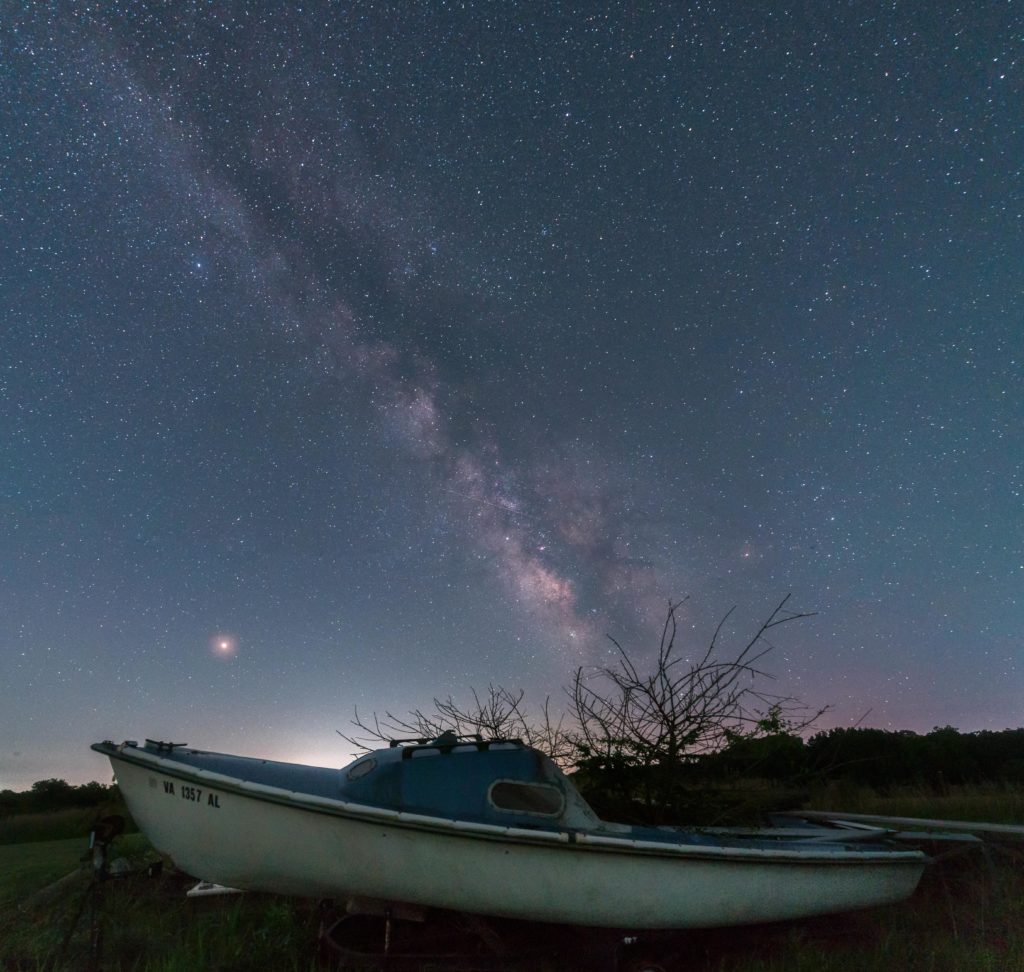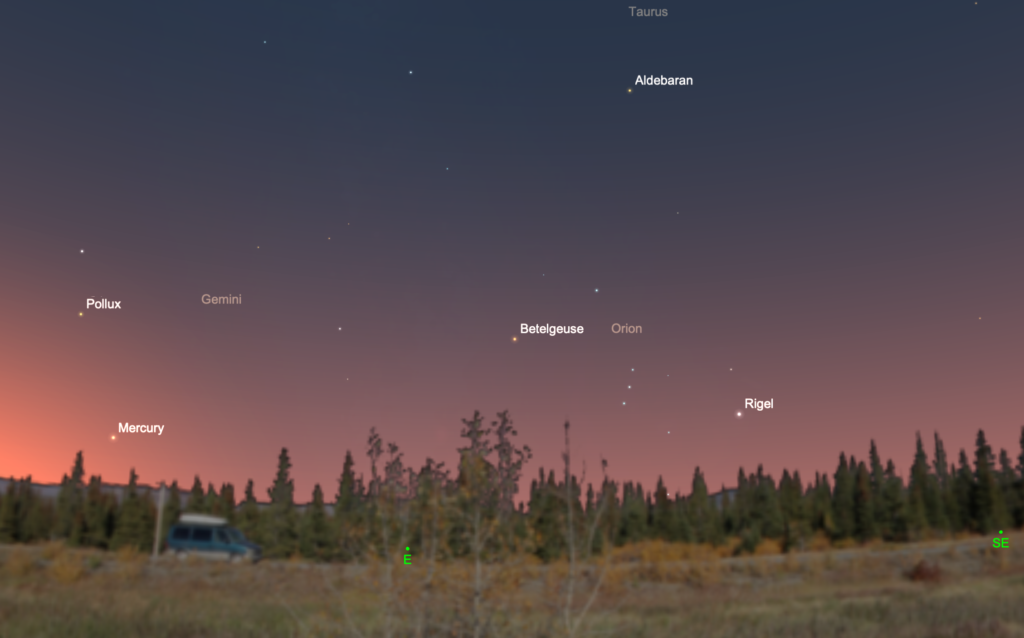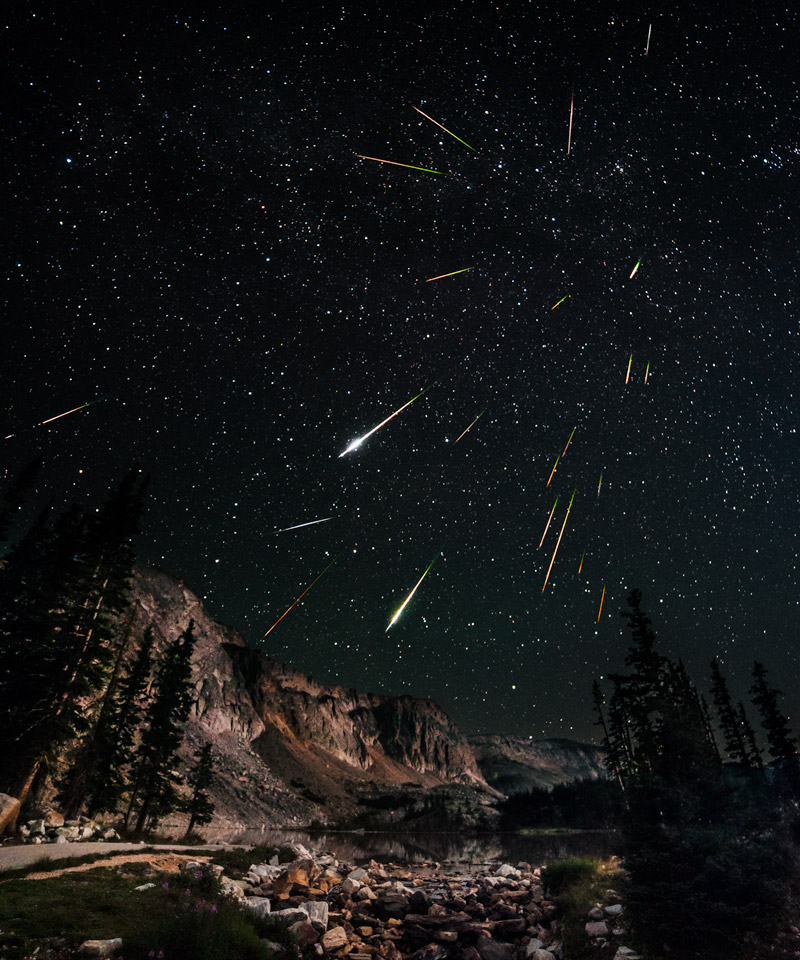
August is usually the finest month for observing the night sky. For northern-hemisphere observers, the weather is still warm, but much of the unsettled and humid summer air dissipates and skies become drier and clearer. Observers in the southern hemisphere enjoy warmer weather as winter nears an end, and the center of the Milky Way, the starriest part of the night sky, lies nearly overhead. This year, Jupiter and Saturn are big, bright, and beautiful in a telescope, while tiny Mercury emerges above the eastern horizon before sunrise. The great Perseid meteor shower peaks mid month. And another rare, if meaningless, occurrence you may hear about in the media: there are two new moons in August, the second of which is ludicrously called a “Black Moon”. Here’s what’s going on in the night sky this month.
Note: If you have access to the August 2019 edition of Sky and Telescope magazine, have a read of the article on p.22-27 entitled ‘Small Scope Summer’ written by Brian Ventrudo, the publisher of CosmicPursuits.com. It will describe many deep-sky objects to observe that look better in a small telescope than in a larger instrument.
1 August 2019. New Moon, 03:12 UT.
4 August. A slender waxing crescent Moon finds itself in the ‘arms of the maiden’ Virgo tonight and tomorrow. Today the Moon is just 3o east of the star Porrima (Gamma Virginis), an excellent if tight double star for telescopic observers. Tomorrow, the Moon will be about a fist-width from Spica, the brightest star in Virgo.
7 August. First Quarter Moon, 17:31 UT
7 August. The Moon continues pointing the way to bright stars along the ecliptic as it sits tonight between Alpha and Beta Librae in the faint zodiacal constellation Libra. Alpha Librae is also known as Zubenelgenubi, a name that conjures thoughts of a Star Wars character, but which is in fact Arabic for “southern claw”. The name comes from a time when the star was an extension of the fearsome claws of the brighter constellation Scorpius to the east. While it’s designated as Alpha Librae, Zubenelgenubi is the second-brightest star in Libra after Beta Librae, also known as Zubenelschamali (the “northern claw”). Alpha is a pretty double star in binoculars.
9 August. Mercury reaches greatest western elongation about 19o from the Sun. The speedy little planet will be visible in the east-northeastern sky about 30-60 minutes before sunrise. The alignment of the ecliptic makes this apparition favor northern-hemisphere observers. The planet reaches magnitude 0.0 today, respectably bright, but a pair of binoculars will help you spot it in the brightening dawn sky about 10o above the horizon 30 minutes before sunrise. Southern observers can also see the planet, but it’s much lower over the horizon. Track the planet for the next two weeks as it moves back towards the horizon.

9 August. The waxing gibbous Moon lies about two finger-widths from the brilliant planet Jupiter. The ‘King of Planets’ is slower growing fainter, but it’s still a magnificent sight in the constellation Ophiuchus. Far brighter than any star, it shines at magnitude -2.2 and spans about 40”. The planet continues to move a little westward against the background stars until August 11 when it slowly resumes its eastward prograde motion. Best of all, Jupiter is near its maximum elevation as night falls, so the planet is perfectly placed for observing at respectable hours. Take a look! There’s always something good to see on the face of this endlessly fascinating world. (Editor’s note: For tips on how to observe Jupiter and what to look for, have a look at our Jupiter Observing Guide for 2019).
11 August. Tonight, the waxing gibbous Moon is a few finger widths from Saturn. The ringed planet is far south on the ecliptic just east of the “Teapot” of the constellation Sagittarius. A month past opposition, Saturn fades slightly from magnitude +0.2 to +0.3 and shrinks from an angular diameter of 18.2” to 17.5”. The rings are still beautifully tilted about 24o which makes for dramatic viewing on nights of good seeing. The planet’s position favors southern-hemisphere observers, but northerners can get the best view when the planet crosses the meridian and reaches its highest elevation for the night. This happens at 11:30 p.m. local time at the beginning of August and about 9:30 p.m. by the end of the month. (New to observing Saturn? Our Saturn Observing Guide will help you understand what to see on and around the ringed planet.

12 August. Observers in Australia and New Zealand will see the Moon pass in front of the planet Saturn, which will be a spectacular sight in any telescope! Precise timing and location of the occultation at this link: http://www.lunar-occultations.com/iota/planets/0812saturn.htm
12 August. The Perseid meteor shower peaks in the early-morning hours of August 12-13. This is the finest meteor shower of the year for northern stargazers, with 40-60 meteors per hour visible at the peak in the hours before dawn on August 13. Once called the Tears of St. Lawrence, this meteor shower occurs as the Earth moves through a stream of debris left by Comet Swift-Tuttle. The nearly full Moon, however, gets in the way this year, which means the fainter meteors during the peak will be hard to see. But the Perseids are a long-lasting show, running from July 17 through August 25. So take a look when the Moon is out of the way about a week before or a week after the peak on August 12. With patience and dark sky, you will see some meteors!

14 August. Venus reaches superior conjunction and lies on the same side of the Sun as Earth, lost in the Sun’s glare. The planet will return to the western sky after sunset in September.
15 August. Full Moon, 12:29 UT
23 August. Last Quarter Moon, 14:56 UT
24-25 August. The waning crescent Moon, still fairly thick, passes about 2o from the bright star Aldebaran in the constellation Taurus just over the eastern horizon before dawn on August 24th. On the morning of August 25th, the Moon will pass less than half a degree from Zeta Tauri, one of the stars at the tip of the ‘horns’ of Taurus. Observers in parts of western North America will see the Moon pass in front of Zeta Tauri. Timing and location here.
30 August. New Moon, 10:37 UT. The Moon is also at perigee today, its closest approach to Earth, at a distance of 357,176 km, which means there will be larger than usual tides today. This is also the second New Moon of the month, which the media will refer to as a “Black Moon”. There’s nothing black about it, of course; the far side of the Moon is fully lit by the Sun, as it is with every New Moon.